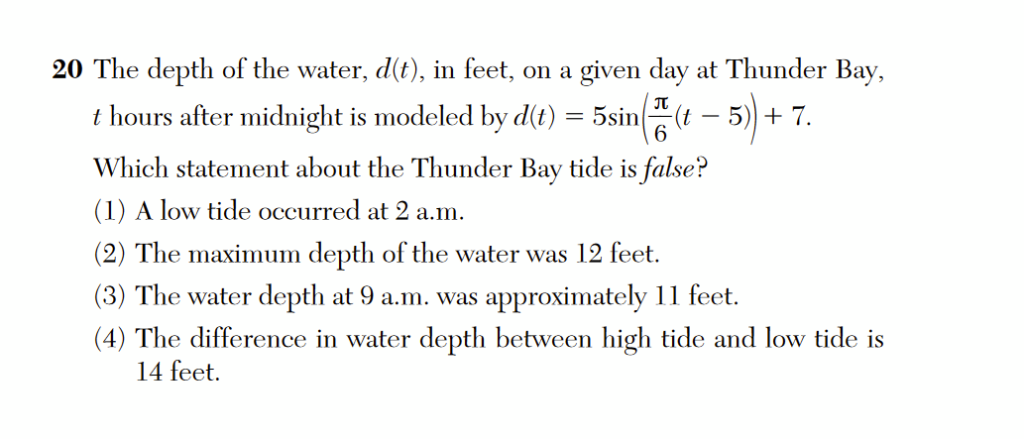When a Model Isn’t a Model
On the one hand, it’s good that standardized math tests are trying to include more examples of mathematical modeling, one of the true applications of math to the real world. On the other hand, if these tests promote a false, even dangerous, idea of what a mathematical model is, then they shouldn’t bother trying.
This question from the New York State Algebra 2 Regents exam commits a fundamental error of mathematical modeling: it confuses the model for the phenomenon itself.
Is the maximum depth of the water 12 feet? We don’t know. The model of the water’s depth, d(t), takes a maximum value of 12 feet, but the model is only an approximation of reality. The actual maximum depth of the water is likely to differ from the model, as are the times of high and low tide. We can’t draw specific conclusions like (1), (2), or (4), we can only approximate. This means that all these statements are probably false.
Oddly enough, answer choice (3) seems to understand that models are just approximations, which makes the other answer choices even less defensible. (And all of this ignores the question of whether or not students have the requisite domain-specific knowledge of oceanography to understand what high- and low- tides are.)
In the grand scheme of these exam errors, this is a minor footnote. But as I’ve argued in these posts, and in my talk g = 4, and Other Lies the Test Told Me, these kinds of errors have a cumulative effect of training students to stop thinking when doing and applying math and instead just try to guess what the question writer wants to hear. We should expect more from our assessments.
Related Posts
- Regents Recaps
- June 2022 Algebra 2 Regents Exam (Twitter Thread)
- Regents Recap — January 2018: Problems with Pre-Calculus
- Regents Recap — August 2015: Modeling Data

1 Comment
Sue Hellman · July 15, 2022 at 11:57 pm
Your words “all of this ignores the question of whether or not students have the requisite domain-specific knowledge of oceanography” are resonating loudly in me tonight. I had an echo cardiogram today and saw something called my TAPSE. It was a picture of the sinusoidal wave created by measuring the velocity of the up & down movement of the floor of the right ventricle of my heart as it pumped blood to my lungs. What a story I have to tell my students when we do trig in Pre-Calc 12 next semester instead of just covering the grandfather clock pendulum and ferris wheel problems in the text. And this led to the clincher … how many learners today will grow up being able to read an analogue clock? And how many will know what a grandfather clock is? They may make out a little better with understanding the ferris wheel problem if they’ve seen one at the Calgary (where they live) Stampede or at a local local fair, but there’s no gut level connection to the text book problem unless they can relive the thrill of riding one. Generational change in frames of reference can be such a challenge. I live in BC so I know tides. I’m 70, so I know grandfather clocks. I went to the CNE as a kid so I know ferris wheels. I’ve ridden a train across the country so I know about 2 trains on a collision course. Few of my students will know about echo cardiograms, but I can bring periodic waves to life by involving them in the drama of my story.